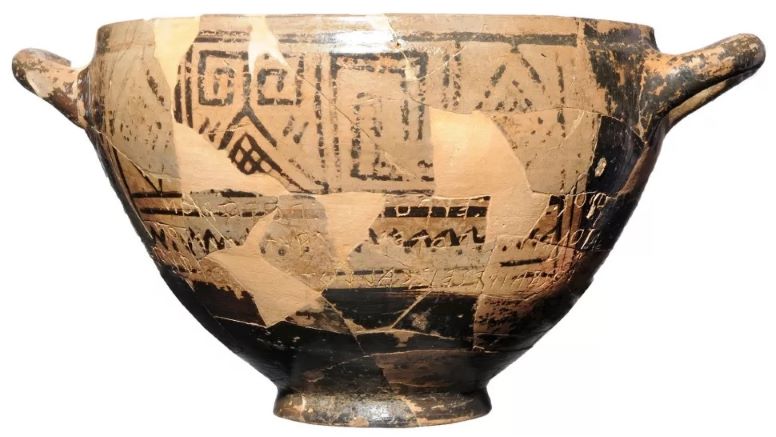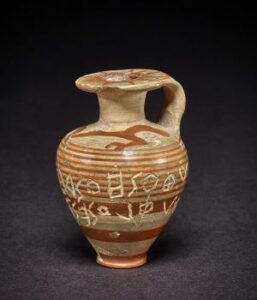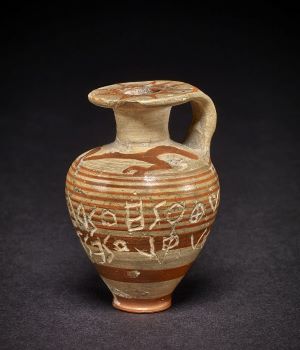It can be easy to fall into the trap of thinking pottery from antiquity as distant to ourselves in the modern day. Savage tales of heroism, brash nudity and a plethora of deities deipicted on them only serve to remind how different the ancient Greeks were. But finds can sometimes do the opposite, namely to illustrate how things are sometimes similar today as they were then. Here are two great examples of ancient Greek pottery with something to say.
Cup of Nestor found at Pithekoussai.
This item dates to around 700 BC and was originally made in Rhodes. It was found on the island of Ischia, in the gulf of Naples and this might seem surprising. Yet ancient Greeks were settling in this region (and I’ll be doing a podcast episode on this in time). In a settlement known as Pithekoussai an item, complete with inscription was found. Like other items it was found in a burial, so perhaps it was a gift or owned by one of the deceased (there is debate over who was buried). The script was written in Euboean Greek, a variation of the language and is one of the earliest surviving examples of script which we have. Today it stands in the Archaeological Museum of Pithecusae.


It’s a beautiful design, but as you’ve guessed it’s really what was written which steals the attention. It translates as something along the lines of:
Nestor’s, the cup good to drink from. But whoever drinks from this cup, immediately the desire of love for Aphrodite with the beautiful crown will seize him
The location of Ischia in southern Italy.I imagine a good few swings were taken from the cup, and aside from the importance is has elsewhere (i.e. that it has that old script) it finds a niche relevance today. Who hasn’t seen (or drunk from) a mug with a welcoming logo on it!
A lekythos from Pithekoussai.
The second example shares some similarities with Nestor’s Cup though it has a very different message. This piece can be found in the British Museum, and is labelled as an aryballos (a vessel normally used for perfumed oil).

It dates to circa 670 BC and though the findspot isn’t known it has been placed in Campania – so in the same region as Nestor’s Cup. It also has an inscription in Euboean Greek and it reads:
I am Tataie’s lekythos, may he who steals me go blind
The inscription describes the item as a lekythos, these were often used to store oil and were commonly found in graves. Perhaps then it’s a warning to any would be grave thief? But perhaps this was an inscription which had purpose when its owner (presumably Tataie) was alive? After all, who hasn’t owned something with a ‘keep your hands off’ message at some point (especially if you grew up with siblings!).
Both items are markedly different but also highly relatable and that’s part of their beauty.
Update: Podcast on Magna Graecia.
Recently I released an episode which featured these pieces and Pithekoussai. You can find the episode notes here and a link to the episode here.



